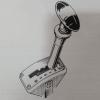I could use some help with some phraseology regarding ignition coils. I think that I heard AC Dodd refer to a 'hi power' coil on one of his tuning videos, usually a 0.8 ohm coil and why its called that? Does the each coil differ in it's discharge voltage? What I don't know is the applicability and why there is a choice of .8, 1.5, and 3.0 ohm coils. 'The .8 ohm coil works with the 65D but increase the plug gap to .035 , a 1.5 will work with a 65D but the plug gap should be .028, the 3.0 ohm coil is fine with a point/condenser system but reduce the plug gap to .025...... and then there is the ballast wire thrown in to add a little variety to the mix.
Thanks


















